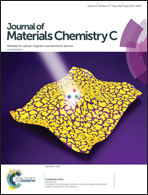Optimizing the defect chemistry of Na1/2Bi1/2TiO3-based materials: paving the way for excellent high temperature capacitors†
Abstract
For applications in automotive, aviation and renewable energy industries temperature and power requirements have been significantly increased for electronic components. In particular, capacitors have been identified as the most critical materials considering the fulfillment of these requirements. Ceramics are the most promising materials for high temperature capacitors but no ceramic has been able to meet the necessary electrical properties so far. In this work, Na1/2Bi1/2TiO3 (NBT) solid solutions are investigated to optimize the respective electrical properties. A reduction of bismuth vacancy and oxygen vacancy concentration by increasing the initial Bi content leads to a significant decrease in dielectric loss. Additionally, energy efficiencies of up to 97% can be achieved for the composition Na1/2Bi1/2O3–BaTiO3–CaZrO3 (NBT–BT–CZ) and the temperature range of stable high permittivity together with low dielectric loss (tan δ ≤ 0.02) extends from −67 °C to 362 °C. Hence, optimization of the defect chemistry of NBT-materials results in highly stable electrical properties over a large temperature and electric field range, which leads to the fulfillment of industrial requirements.



 Please wait while we load your content...
Please wait while we load your content...